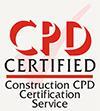This CPD will focus on ISO 9001 and on how firms can ensure their quality management systems are compliant as they become BIM Level 2 ready. It is sponsored by Newforma

How to take this module
UBM’s CPD distance-learning programme is open to anyone seeking to develop their knowledge and skills. Each module also offers members of professional institutions an opportunity to earn between 30 and 90 minutes of credits towards their annual CPD requirement.
This article is accredited by the CPD Certification Service. To earn CPD credits, read the article and then click the link below to complete your details and answer the questions. You will receive your results instantly, and if all the questions are correctly answered, you will be able to download your CPD certificate straight away.
CPD CREDITS: 30 MINUTES
DEADLINE: 9 JUNE 2016

![]()
INTRODUCTION
The ISO 9000 series of standards was developed by the International Organisation for Standardisation, and addresses various aspects of quality assurance. It is intended to support companies and organisations to ensure that their products and services consistently meet expectations and that quality is consistently improved. This CPD will focus on the most widely known part of the standard, ISO 9001, and on how firms can ensure their quality management systems are compliant as they become BIM Level 2 ready.
ISO 9001 COMPLIANCE
There are a number of standards in the ISO 9000 family, including:
- ISO 9000:2015, which covers the basic concepts and language
- ISO 9001:2015, which sets out the requirements of a quality management system (QMS)
- ISO 9004:2009, which focuses on how to make a quality management system more efficient and effective
- ISO 19011:2011, which sets out guidance on internal and external audits of quality management systems.
ISO 9001 is the only standard in the family that can be certified to. It was first published in 1987, and the latest revision took place in 2015, replacing the 2008 version. ISO 9001:2015 has a greater focus on risk management, reflecting the increasing complexity of global supply chains and the growing expectations of customers, who have greater access to information and a stronger voice.
The two key differences are a new structure, so that ISO 9001:2015 now follows the same overall structure as other ISO management system standards such as ISO 14001 for environmental management systems, and the greater prominence of risk-based thinking. It also puts greater emphasis on leadership engagement and addresses supply chain management more effectively.
Organisations which have already achieved ISO 9001:2008 and wish to maintain their certification must transition their quality management system to the new version and seek certification again. There is a three-year transition period from the date of publication of the revised standard (September 2015). After September 2018, a certification to ISO 9001:2008 will no longer be valid.
The most significant changes include:
- Organisational context: the design and implementation process for a quality management system must include consideration of an organisation’s context
- Risks and opportunities: there is a new requirement to identify the risks and opportunities that could impact the operation and performance of the quality management system, as well as the corresponding “proportionate” actions to address them
- Leadership: top-level management is required to demonstrate a greater direct involvement in the quality management system, with a greater focus on “leadership” as opposed to purely managing the system
- Documented information: the terms “documented procedure” and “record” used in the previous version have been replaced throughout by the term “documented information”. This is defined as information that is required to be controlled and maintained by an organisation to control the quality management system, and it is up to each organisation to determine the level and type of documentation necessary.
Achieving ISO 9001 certification can be challenging and resource-intensive. The process requires extensive external audits of procedures, build quality and managerial practices across an organisation.

BIM CERTIFICATION
From April this year, all centrally procured government projects of any size will have to be carried out using building information modelling (BIM) to level 2. This target was set in the UK government’s March 2011 strategy paper on BIM, in which level 2 was defined as a situation where each discipline creates its own model and these are shared throughout the team, with all project data shared electronically as a common resource.
BRE Global has developed a certification scheme to allow companies to demonstrate that they have the capability to work to the government’s level 2 BIM requirements.
The BRE BIM Level 2 Business Systems Certification scheme assesses a business’ BIM policy and capability, as defined within two “publicly available specifications”:
- PAS 1192-2:2013 – Specification for information management for the capital/delivery phase of construction projects using building information modelling
- PAS 91:2013 – Construction prequalification questionnaires. Question O4-Q2 asks whether a company has “documented policy, systems and procedures” in place to achieve level 2 BIM. With BIM certification, a company does not have to provide evidence of competence for every tender.
It also assesses the ability of the business to meet the requirements of an employer to carry out a BIM capability assessment.
The scheme requires the completion of an online application, followed by a desktop assessment to ensure appropriate policies and procedures are in place, followed by an onsite audit to confirm compliance.
BRE Global has also developed a scheme for individuals, BIM Level 2 Certificated Practitioners, assessed through a combination of regular audits and ongoing CPD requirements. It has three defined categories of membership, following the assigned roles identified in PAS 1192-2:2013: project information manager (PIM), task information manager (TIM) and project delivery manager (PDM).
BIM AND ISO 9001 COMPLIANCE
Architecture and engineering firm BDP was the first UK business to be certified under the business systems scheme in November 2014. As part of this process, it also conducted an audit to ensure its processes were compliant with ISO 9001.
Firms wishing to ensure that they become or remain compliant with ISO 9001, as they carry out projects to level 2 BIM can follow a series of steps:
1. Internal testing
Before an auditor comes in, a business needs to carry out its own internal review and audit to highlight areas that need attention – demonstrating that procedures are being followed and not merely documented is important. Storing, recording and managing documents is vital to ISO 9001 certification, but this can be difficult when teams are using a variety of design tools and systems to create, update, view and share BIM models. BDP overcame this problem by using Newforma’s project information management software. This provides a single point of access for project files, regardless of which cloud storage system is being used, allowing BDP to develop its own bespoke ISO-compliant procedures.
2. Project management
Once areas for attention have been identified and a procedure put in place, management becomes the next key focus. One way to make this easier is by creating a management handbook that includes all the quality assurance procedures that need to be followed, as well as deadlines for when they should be completed. As part of its own ISO 9001 process, BDP implemented a traffic light system, assigning a colour (red, amber or green) against milestones. There are used in the following way:
- Red – the action is not completed within the defined timescale
- Amber – the action is not yet done but the due date has not passed
- Green – all is good: the action has been completed within the timescale
By checking the colour associated with a specific task, project managers can easily verify if a task needs additional attention or not. Included with each task is a short one or two-page brief with additional information for teams.
Compliance with ISO 9001 is a continuous focus, and procedures and practices must be continually reviewed and refined. Keeping the compliance view very granular enables teams to more easily see what needs to be updated. Having a clear way to check that procedures are being followed and compiled with also makes the auditing process much faster and easier.

3. Adapting to BIM
Existing quality management procedures are not necessarily able to cope with technological change, so constant refinement is essential. In particular, BIM puts pressure on document control procedures which were developed for a slower, 2D or paper-based design process. For example, it enables thousands of two-dimensional construction drawings to be generated from a three-dimensional model in minutes. As a result, there is an increase in the amount of information created, both in terms of designs themselves but also associated communications such as emails, notes and meeting minutes and agendas. This means it is important to have a project information management system in place.
UK businesses can also draw on the guidance contained in British standard BS 1192:2007+A1:2015, which supports PAS 1192-2, and PAS 1192-3:2014 (which covers the operational management of assets using BIM). This states that businesses should maintain a document register for each project to keep track of the key attributes of every model and drawing revision, along with logging when, to whom and for what reason each revision was issued. This not only helps control the spread and access of documents, but also prevents leaks of sensitive information.
4. Simplification
ISO 9001 certification can be aided by further refinement and simplification of processes. Removing unnecessary steps in certain processes can greatly reduce the workload for project managers, allowing them to focus on the key procedures. This is often done as part of the audit prep work, where systems can be reviewed and refined. Simplification has the added benefit of speeding up processes and improving efficiency. To achieve this, teams could mimic external auditors themselves, by asking the questions that ISO auditors will ask in the final audit.
To summarise, the key questions that firms should ask before embarking on ISO 9001 certification are:
- Are our current processes as simple and clear as they can be?
- Can project managers and team members stick to procedures and hit deadlines?
- Are we ready for an internal audit?
- Are we correctly storing, managing and handling documents?
- Do we have a project information management system in place?
- What digital tools can help us achieve ISO 9001 accreditation?

How to take this module
UBM’s CPD distance-learning programme is open to anyone seeking to develop their knowledge and skills. Each module also offers members of professional institutions an opportunity to earn between 30 and 90 minutes of credits towards their annual CPD requirement.
This article is accredited by the CPD Certification Service. To earn CPD credits, read the article and then click the link below to complete your details and answer the questions. You will receive your results instantly, and if all the questions are correctly answered, you will be able to download your CPD certificate straight away.
CPD CREDITS: 30 MINUTES
DEADLINE: 9 JUNE 2016
Privacy policy
Information you supply to UBM Information Ltd may be used for publication and also to provide you with information about our products or services in the form of direct marketing by email, telephone, fax or post. Information may also be made available to third parties. UBM Information Ltd may send updates about Building CPD and other relevant UBM products and services. By providing your email address you consent to being contacted by email by UBM Information Ltd or other third parties. If at any time you no longer wish to receive anything from UBM Information Ltd or to have your data made available to third parties, contact the Data Protection Coordinator, UBM Information Ltd, FREEPOST LON 15637, Tonbridge, TN9 1BR, Freephone 0800 279 0357 or email ubmidpa@ubm.com. View our full privacy policy at www.building.co.uk/cpd





























2 Readers' comments